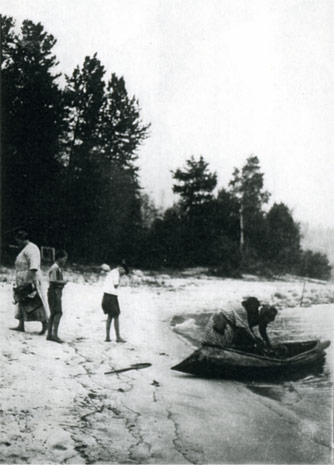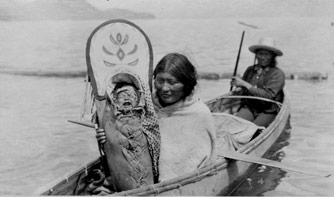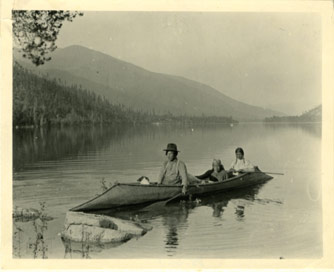- Français
- English


INDIGENOUS WATER TRANSPORT
The first boats to ply the waters of Kootenay Lake and the West Arm were made not of wood or steel, but of bark. The First People living in the region created a marine culture that depended heavily on boats to navigate the landscape. Both the Sinixt (Arrow Lakes Indians) and the Ya-qan nu-kiy (Lower Kootenay Indian Band of the Ktunaxa Nation) used the unique sturgeon-nosed canoe as their primary method of transportation.
Kootenay Lake is a long, wide lake that covers the valley bottom for over 100 kilometers in length. The mountains that surround the lake are steep, and the rivers that feed the lake form extensive deltas that are marshy and prone to flooding. To travel the region, the First People sometimes crossed high mountain passes - a challenge at the best of times and not an option in the months of deep snow. More often, they followed the rivers and lakes along the narrow, water-filled valleys. In order to navigate the slow-moving shallow marshes, to cross large lakes prone to sudden storms or to ride river rapids, the First People needed a canoe of a unique shape.
The sturgeon nosed canoe - named for the downward-pointing ends of both the bow and the stern - was well-adapted to the varied water conditions of the region. Its light weight and utility were admired by early European explorers, as was its ability to be quickly repaired when the bow hit a rock. First Nations people sometimes stored their canoes for a season or longer by submerging them in the cold shoreline water, held fast by a few weighted stones. The design of the canoe is unique to this region of North America, although similar designs have been found in Northern Russia.
As Europeans began to settle in the region, the First People adapted to the use of canvas instead of bark for sheathing the hull. They continued to use their traditional canoes even as the sternwheelers began to navigate the waters of Kootenay Lake and the West Arm. Photographs from the first three decades of the 20th century show the First People still finding their way around the area as they had for thousands of years. As the sternwheeler period came to close when overland transportation routes were established, so, too did the much longer era of the sturgeon-nosed canoe.

VIDEO: Sturgeon Nosed Canoe
Media Clip Description: A short clip of a sturgeon nosed canoe on the West Arm of Kootenay Lake. This film was taken by Reverend George Kinney of the United Church of Canada while he worked on his Kootenay Waterway Mission, traveling up and down Kootenay Lake visiting small and isolated communities in the late 1920s.




